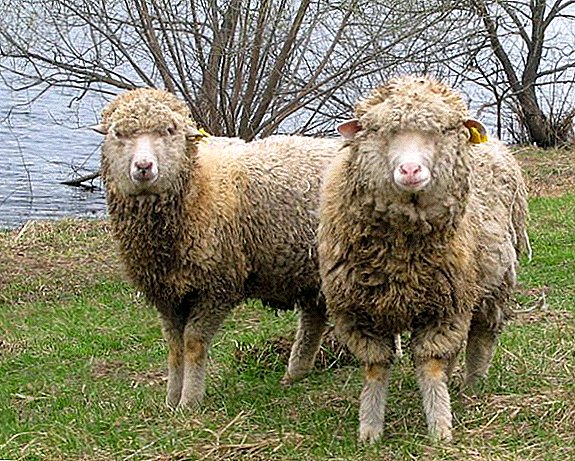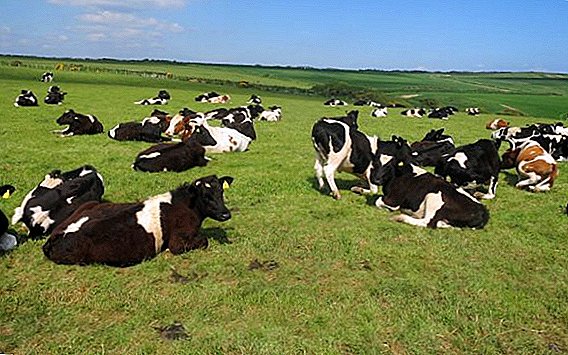 Necrobacteriosis of cattle is an infectious disease that affects wild and domestic ungulates. The fall of livestock in this case occurs rarely, with the exception of young stock, among which the figure can reach 80%. Among the consequences of the disease - the fall in milk yields and the need for intensive treatment of livestock.
Necrobacteriosis of cattle is an infectious disease that affects wild and domestic ungulates. The fall of livestock in this case occurs rarely, with the exception of young stock, among which the figure can reach 80%. Among the consequences of the disease - the fall in milk yields and the need for intensive treatment of livestock.
What is Necrobacteriosis
The disease affects the skin, mucous membranes and internal organs of ungulates. The disease has been known to mankind for a long time under various names. To unite them in one disease allowed the discovery of the bacilli causing necrosis in 1881 by R. Koch.
Necrobacteriosis strikes cattle in dysfunctional herds. The stick Fusobacterium necrophorum can live for a long time in a humid environment of faeces, but quickly dies upon contact with any disinfectants. Necrobacteriosis susceptible to animals in regions with a cold climate, living in polluted barns.

Pathogen, sources and routes of infection
The causative agent of the disease is a gram-negative anaerob Fusobacterium necrophorum, which is not capable of movement. As a result of active reproduction produces toxins that cause inflammation in the tissues of the body, followed by the development of suppuration and necrosis of tissues.
Carriers of the disease - recovered animals and objects in contact with a sick animal - bedding, feces, food. The infection enters the body through any wound surfaces, including damage to the hoof or skin.
Did you know? Anaerobes - these are bacteria that do not need oxygen for their development and reproduction. This term was first introduced by L. Pasteur in 1861.
Symptoms of defeat
Symptoms of necrobacteriosis:
- purulent lesions on the skin, udder, legs of a cow;
- ulcers and swelling of mucous membranes.
 The manifestation of the vital activity of the body is no different from the characteristics of the wound surfaces. At the border between the healthy and the affected area, a stable demarcation line is formed. The inflammation does not transfer to other tissues, and if the cow’s immune system copes with it, the pus is encapsulated and disappears, and the place heals.
The manifestation of the vital activity of the body is no different from the characteristics of the wound surfaces. At the border between the healthy and the affected area, a stable demarcation line is formed. The inflammation does not transfer to other tissues, and if the cow’s immune system copes with it, the pus is encapsulated and disappears, and the place heals.If the body is weak, then the spread of the inflammatory process continues to the other tissues, tendons, and bones.
Learn more about diseases of the udder, hooves, joints in cows.And then manifested by the following symptoms:
- general intoxication of the body;
- depressed state;
- fever;
- violation of the internal organs;
- decreased appetite;
- drop in yields;
- cows have mastitis;
- the animal lies a lot.

If untreated, the cow dies from exhaustion.
Important! Anaerobes always affect the body during a period of weakened immunity or a violation of the general microflora.
Laboratory diagnosis
Diagnosis consists of 3 stages:
- examination of smears of affected tissues and mucous membranes;
- biochemical analysis of feces and urine;
- investigation of salivary gland secretions.
Pathological manifestations
When examining a dead animal, there is swelling of the mucous and internal organs, a general depletion of the body, gray cheesy plaque on the mucous membranes. Underneath are ulcers of various sizes, filled with thick, viscous pus. At the advanced stage, damage of various tissues, including bones, can be observed.

Eradication and treatment activities
The sick animal is isolated, the barn is disinfected and cleaned. The cow processes all wound surfaces and treats with tetracycline antibiotics.
Did you know? If you eliminate all the factors that relate to the adverse conditions of cows, the incidence of livestock is reduced by 90%. And only 10% - This is a random infectious or viral infection.
Foot disinfection
Foot baths are set down the aisle in which animals move. The composition of the bath - 10% aqueous solution of zinc sulfate. Replace zinc sulfate can be "Zinc Salt". Apply a foot bath need after treating the hoof of the animal - intensive cleaning and trimming. "Zincosol" destroys pathogens. The hoof should be immersed in the bath to a depth of at least 20-25 cm. Treatment time is at least 3-5 minutes daily.
Video: how to use foot baths for cattle
Hoof surgery
All necrotic tissue, including fistulas and delaminated areas of the hoof, should be completely removed from the hooves. In the surgical removal of all affected areas, it must be remembered that the success of treatment depends on how completely dead tissue sections, including the bones, have been removed. Peeled hooves are processed twice with a 1% alcohol solution "Tripoflavin".
Important! Cattle hooves must be treated twice a year for the purpose of prevention. Horny layer is trimmed, elimination of bends and cracks.
Antibiotics
Treatment of the wound consists in cleaning it from pus and removing the affected tissues with wound disinfection with Chlorhexidine, hydrogen peroxide or another antibacterial agent and applying a wound healing ointment, for example, zinc. Anaerobic Fusobacterium necrophorum is particularly sensitive to tetracycline antibiotics, so the cow is prescribed a course of antibiotics.  The use of Dibiomycin, a synthetic antimicrobial antibiotic with a prolonged duration of action, will create a therapeutic effect for 7 days, after which the administration of the drug is repeated. The dosage of the drug - 20000 U / kg animal weight intramuscularly, once.
The use of Dibiomycin, a synthetic antimicrobial antibiotic with a prolonged duration of action, will create a therapeutic effect for 7 days, after which the administration of the drug is repeated. The dosage of the drug - 20000 U / kg animal weight intramuscularly, once.
Learn how to treat lichen, purulent mastitis, brucellosis, fever, bursitis, babesiosis, anaplasmosis, avitaminosis, acidosis, leptospirosis, EMCAR, allergies, scarring, hypodermatosis in cows.
Can I drink milk and eat meat of sick animals
Necrobacteriosis is an infectious contagious disease, therefore, in contact with sick animals, precautions should be observed.
Milk sick cows can be eaten after a thorough pasteurization. The meat of cows in the advanced stage of necrobacteriosis is to be destroyed. For the rest of the meat, laboratory tests are conducted, on the basis of which it is decided whether it can be eaten.
Animal skins can be dried in an isolated room, disinfected and then sold. 
Prevention and vaccine against cattle necrobacteriosis
Basic preventive measures:
- First of all, it is necessary to take care of the cleanliness in the barn, since the pathogen is destroyed by any disinfectants. Prophylactically, after cleaning the manure, the floor is treated with a mixture of slaked lime and ash. This prevents the development of the pathogen.
- The nutrition of the cow should ensure the rate of intake of minerals and vitamins. For acidification of water used "Stabifor". The drug accelerates the fermentation of feed and reduces bacterial contamination.
- Cow hooves need periodic cleaning and pruning. For their processing use birch tar. If a hoof is suspected to be infected, it is treated after cleaning with aerosol antibiotics.
- Vaccination against necrobacteriosis is carried out with a special vaccine 2 times a year with an interval of 6 months.
Important! The slaughter of cattle meat after the use of antibiotics is possible no earlier than after 6 days, regardless of what the cow is being treated for.In order for infectious diseases not to reduce livestock, it is necessary to carefully observe the sanitary and hygienic norms for keeping cows, vaccinate them in time and provide animals with high-quality feed. If an infection is suspected, you should take immediate action and not start the disease.
Necrobacteriosis treatment
Reviews
1. Intramuscularly daily: penicillin (10 thousand per 1 kg of live weight); 15% weighed. tetracycline 5-10 thousand per kg; biomitsin (15-20 thousand per kg); oxytetracycline (5-10 thousand per kg).
2. Introduce prolonged antibiotics: Diobiomycin (20-30 thousand / kg 1 time in 10 days); Bicillin-3 (30–50 thousand / kg once every 3 days); Bicillin-5 (30–50 thousand / kg once every 5 days). These antibiotics can be introduced into the affected articular cavity in the form of a 1% solution in 0.5% novocaine.
3. Aerosonic forms of chloramphenicol-based antibiotics, tetracycline, and tylosin are effective and economical in local antibiotic therapy.
4. At our farm now for the prevention of using a new drug - Pedilayn. Foot baths are made in a 2% solution continuously, and in a 5% solution for 5 days every month.
Application of ointments and emulsions to affected areas is less effective and more laborious, since it is necessary to apply dressings.














